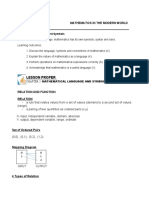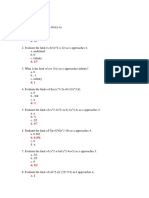Maths Answer to
Uploaded by
abenipopMaths Answer to
Uploaded by
abenipopHere are the answers to the questions in the source document:
**Exercise 2.7**
**1. Find the domain of the given function.**
* a) f(x) = 1/6^x. The domain is all real numbers.
* b) g(x) = √3^x + 1. The domain is all real numbers.
* c) h(x) = √2^x - 8. For the function to be defined, 2^x - 8 ≥ 0, so 2^x ≥ 8, and x ≥ 3. The
domain is x ≥ 3.
* d) f(x) = 1/(2^x-2). For the function to be defined, 2^x-2 ≠ 0, so x ≠ 1. The domain is all real
numbers except x=1.
**2. Sketch the graph of the given function. Identify the domain, range, intercepts and
asymptotes.**
* a) y = 5^-x. The domain is all real numbers, the range is y>0, the y intercept is (0,1) and the
asymptote is y=0.
* b) y = 9 - 3^-x. The domain is all real numbers, the range is y<9, the y intercept is (0,8), and
the asymptote is y=9.
* c) y = 1 - e^-x. The domain is all real numbers, the range is y<1, the y intercept is (0,0) and
the asymptote is y=1.
* d) y = e^-2x. The domain is all real numbers, the range is y>0, the y intercept is (0,1), and the
asymptote is y=0.
**3. Solve the given exponential equation.**
* a) 2^(x-1) = 8. Since 8 = 2^3, then x - 1 = 3, so x = 4.
* b) 3^(2x) = 243. Since 243 = 3^5, then 2x = 5, so x = 5/2.
* c) 8^x = √2. Since 8 = 2^3 and √2 = 2^(1/2), then 3x = 1/2, so x = 1/6.
* d) 16^(x-2) = 1/4. Since 16 = 2^4 and 1/4 = 2^-2, then 4(x-2) = -2, then x - 2 = -1/2, so x = 3/2.
**4. Let f(x) = 2^x. Show that f(x+3) = 8f(x).**
* f(x+3) = 2^(x+3) = 2^x * 2^3 = 8 * 2^x = 8f(x).
**5. Let g(x) = 5^x. Show that g(x-2) = (1/25)g(x).**
* g(x-2) = 5^(x-2) = 5^x * 5^-2 = 5^x * (1/25) = (1/25)g(x).
**6. Let f(x) = 3^x. Show that f(x+2) - f(x) = 4(3^x).**
* f(x+2) - f(x) = 3^(x+2) - 3^x = 3^x * 3^2 - 3^x = 9*3^x - 3^x = 8*3^x. There appears to be a
mistake in the text. The correct answer is 8(3^x) and not 4(3^x).
**7. Evaluate the given logarithmic expression (where it is defined).**
* a) log₃ 32. This cannot be simplified further without a calculator.
* b) log₉ 9 = 1, since 9^1 = 9.
* c) log₅ (-9). This is not defined, since the argument of a log function must be greater than 0.
* d) log₆ (1/36) = -2, since 6^-2 = 1/36.
* e) log₅ (log₃ 243). Since 3^5 = 243, then log₃ 243 = 5. Therefore, log₅ (log₃ 243) = log₅ 5 = 1.
* f) 2log₂(√3). 2log₂(√3) = 2log₂(3^(1/2)) = 2(1/2)log₂(3) = log₂(3).
**8. If f(x) = log₂(x²-4), find f(6) and the domain of f.**
* f(6) = log₂(6² - 4) = log₂(36 - 4) = log₂(32) = 5, since 2^5 = 32.
* For the domain, x² - 4 > 0, so x² > 4. Therefore x > 2 or x < -2.
**9. If g(x) = log₂(x² - 4x + 3), find f(4) and the domain of g.**
* The function is g(x), not f(x). The requested value should be g(4). g(4) = log₂(4² - 4*4 + 3) =
log₂(16 - 16 + 3) = log₂(3).
* For the domain, x² - 4x + 3 > 0. Factoring gives (x-3)(x-1)>0, so x>3 or x<1.
**10. Show that logₓ x = -logₓ (1/x).**
*logₓ (1/x) = logₓ (x^-1) = -1logₓ x = -logₓ x.
**11. Sketch the graph of the given function and identify the domain, range, intercepts and
asymptotes.**
* a) f(x) = log₂(x-3). Domain: x > 3, Range: all real numbers, Intercept: (4, 0), Asymptote: x = 3.
* b) f(x) = -3 + log₁₀ x. Domain: x > 0, Range: all real numbers, Intercept: (1000, 0), Asymptote:
x = 0.
* c) f(x) = -log₁₀(-x). Domain: x < 0, Range: all real numbers, Intercept: (-1, 0), Asymptote: x=0.
* d) f(x) = 3log₁₀x. Domain: x > 0, Range: all real numbers, Intercept: (1, 0), Asymptote: x = 0.
**12. Find the inverse of f(x) = e^(x+1).**
* Let y = e^(x+1). To find the inverse, switch x and y to get x = e^(y+1). Take the natural
logarithm of both sides to get ln(x) = y + 1. Therefore, y = ln(x) - 1. The inverse is f⁻¹(x) = ln(x) -
1.
**13. Let f(x) = e^x. Find a function so that (f o g)(x) = (g o f)(x) = x.**
* The inverse of f(x) is f⁻¹(x) = ln(x). Therefore, g(x) = ln(x).
**14. Convert the given angle from radians to degrees.**
* a) π/6 = (π/6) * (180/π) = 30°
* b) -π/4 = (-π/4) * (180/π) = -45°
* c) -5π/4 = (-5π/4) * (180/π) = -225°
**15. Convert the given angle from degrees to radians.**
* a) 315° = 315 * (π/180) = 7π/4
* b) -40° = -40 * (π/180) = -2π/9
* c) 330° = 330 * (π/180) = 11π/6
**16. Sketch the graph of**
* a) f(θ) = sec θ
* b) f(θ) = 1 + cos x
* c) f(θ) = csc θ
* d) f(x) = sin(x + π/2)
* e) f(θ) = cot θ
* f) f(x) = tan 2x
* These will be standard trigonometric functions and shifted trigonometric functions.
**17. Verify the following identities.**
* a) (sin x - cos x)(csc x + sec x) = tan x - cot x. Expand to get sinx cscx + sinx secx - cosx cscx
- cosx secx. This is equal to 1+ tanx - cotx -1 = tanx - cotx.
* b) sec² x - csc² x = tan² x - cot² x. Since sec²x = 1 + tan²x, and csc²x = 1 + cot²x, then sec²x -
csc²x = 1 + tan²x - 1 - cot²x = tan²x - cot²x.
**18. Given tan θ = 1/2 and sin θ < 0, find cos θ.**
* Since tan θ is positive and sin θ is negative, θ must be in the third quadrant where cosine is
also negative. The identity tan² θ + 1 = sec² θ is useful. (1/2)² + 1 = sec² θ. sec² θ = 5/4, and
sec θ = -√(5)/2. Since cos θ = 1/sec θ, then cos θ = -2/√5 = -2√5/5.
You might also like
- Section 1.7 Combinations of Functions: Composite FunctionsNo ratings yetSection 1.7 Combinations of Functions: Composite Functions28 pages
- Math 1105 (11) : Solutions To Assignment #1No ratings yetMath 1105 (11) : Solutions To Assignment #14 pages
- The 2 Annual Johns Hopkins University High School Math TournamentNo ratings yetThe 2 Annual Johns Hopkins University High School Math Tournament7 pages
- Capitolul I INTEGRALE (Recapitulareliceu) : Funcţii Elementare Funcţii Compuse 1) 2) 3) 4) 5)No ratings yetCapitolul I INTEGRALE (Recapitulareliceu) : Funcţii Elementare Funcţii Compuse 1) 2) 3) 4) 5)49 pages
- MATH1010 University Mathematics Supplementary ExerciseNo ratings yetMATH1010 University Mathematics Supplementary Exercise24 pages
- Polynomilas Rational Function - Study GuideNo ratings yetPolynomilas Rational Function - Study Guide9 pages
- This Question Paper Consists of 8 Printed Pages Including This PageNo ratings yetThis Question Paper Consists of 8 Printed Pages Including This Page6 pages
- Factoring and Algebra - A Selection of Classic Mathematical Articles Containing Examples and Exercises on the Subject of Algebra (Mathematics Series)From EverandFactoring and Algebra - A Selection of Classic Mathematical Articles Containing Examples and Exercises on the Subject of Algebra (Mathematics Series)No ratings yet
- Analytic Geometry: Graphic Solutions Using Matlab LanguageFrom EverandAnalytic Geometry: Graphic Solutions Using Matlab LanguageNo ratings yet
- Trigonometric Ratios to Transformations (Trigonometry) Mathematics E-Book For Public ExamsFrom EverandTrigonometric Ratios to Transformations (Trigonometry) Mathematics E-Book For Public Exams5/5 (1)
- Mathematics 1St First Order Linear Differential Equations 2Nd Second Order Linear Differential Equations Laplace Fourier Bessel MathematicsFrom EverandMathematics 1St First Order Linear Differential Equations 2Nd Second Order Linear Differential Equations Laplace Fourier Bessel MathematicsNo ratings yet
- Logical progression of twelve double binary tables of physical-mathematical elements correlated with scientific-philosophical as well as metaphysical key concepts evidencing the dually four-dimensional basic structure of the universeFrom EverandLogical progression of twelve double binary tables of physical-mathematical elements correlated with scientific-philosophical as well as metaphysical key concepts evidencing the dually four-dimensional basic structure of the universeNo ratings yet
- De Moiver's Theorem (Trigonometry) Mathematics Question BankFrom EverandDe Moiver's Theorem (Trigonometry) Mathematics Question BankNo ratings yet
- 9. Chapter 9 - Sequence and Arithmetic SeriesNo ratings yet9. Chapter 9 - Sequence and Arithmetic Series36 pages
- Basis Functions: Introduction To Group TheoryNo ratings yetBasis Functions: Introduction To Group Theory21 pages
- Fortescue Transformations For Three-Phase Power Flow Analysis in Distribution NetworksNo ratings yetFortescue Transformations For Three-Phase Power Flow Analysis in Distribution Networks7 pages
- M.sc. Maths & Computing Syllabus AR 2018No ratings yetM.sc. Maths & Computing Syllabus AR 201857 pages
- 08 Sequence Series Revision Notes QuizrrNo ratings yet08 Sequence Series Revision Notes Quizrr36 pages
- Secondary School-HKUST Dual Program: Pre-Stage Level PhysicsNo ratings yetSecondary School-HKUST Dual Program: Pre-Stage Level Physics101 pages
- 20-01-2020 Quadratic Equation JEE Mains PPT (Maths) Crash CourseNo ratings yet20-01-2020 Quadratic Equation JEE Mains PPT (Maths) Crash Course36 pages
- Solution of The Diffusion Equation: Introduction and Problem DefinitionNo ratings yetSolution of The Diffusion Equation: Introduction and Problem Definition37 pages
- Mathematical Preliminaries: 1.2 Roundoff Errors and Computer ArithmeticNo ratings yetMathematical Preliminaries: 1.2 Roundoff Errors and Computer Arithmetic16 pages
- Root Locus Diagram - GATE Study Material in PDF100% (1)Root Locus Diagram - GATE Study Material in PDF7 pages
- X X X X X X X X X X X X X X: Sec Tan Sin Tan Sin CSC Cot Cos CSC Cot Cot Cos Tan Sec100% (1)X X X X X X X X X X X X X X: Sec Tan Sin Tan Sin CSC Cot Cos CSC Cot Cot Cos Tan Sec7 pages

























































































